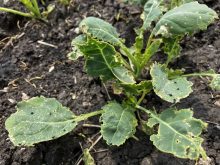Canola should be swathed when 60 per cent of the seeds on the main stems have changed colour and that means taking a close look at your fields.
“You really just can’t make an accurate assessment of seed colour change from your pickup truck,” the Canola Council of Canada’s Manitoba agronomy specialist Angela Brackenreed said during a webinar Aug. 7. “Even if you’ve grown canola for a really long time you may see differences. You really need to get out there and start taking a look at the main stem and crack open some pods.”
Read Also

Critical growing season is ahead for soybeans
What the weather turns out to be in the United States is going to have a significant impact on Canadian producers’ prices
Canola swathing was in full swing last week through much of eastern and central agro-Manitoba. A few fields are already in the bin, she said later in an interview.
“I’m hearing yields from 20 to 40 bushels an acre,” Brackenreed said.
Although still early in the harvest Brackenreed is guessing Manitoba canola yields will average around 30 bushels an acre.
“I think there might be a little bit of disappointment,” she said. “We just didn’t get the moisture when we really needed it.”
While this year’s crop got off to a strong, early start, many areas experienced hotter temperatures than normal. Timely rains would have boosted yields.
Average yields
Last year Manitoba canola farmers averaged almost 29 bushels an acre; the five-year average is 34.6, according to the Manitoba Agricultural Services Corporation’s crop insurance records.
Picking the ideal swathing time is a judgment call. Some farmers begin swathing early because they have so many acres to do.
“The worst combination is to prematurely swath on a hot, dry day,” Brackenreed said. “That is going to lead to the worst yield and quality.
“Swathing in the heat will lead to rapid desiccation of the seed and this can obviously lead to higher levels of green seed. The chlorophyll just doesn’t get a chance to be cleared from the seed.”
If it’s a 30° day and dry, opt to swath in the evening or early morning when it’s cooler and there’s a chance for dew.
To assess seed colour change, Brackenreed said farmers should select main stems from representative areas of the field, then divide the plants into thirds. Canola seeds ripen from the bottom up and from the inside of the stem out.
Seeds from the bottom third of the main stem should be ripe, seeds from the middle should be almost changed colour and seeds from the top third still green. Those top green seeds should be firm, but pliable and not fall apart when rolled between your fingers.
Usually in Manitoba canola is ready to swath 25 days after flowering ceases, Brackenreed said. It takes about 30 days in Alberta and somewhere in between in Saskatchewan.
Typically after flowering there will be a 10 per cent seed colour change every two to three days so farmers should be checking often. The change occurs faster under hot, dry conditions.
Swathing
Swathing canola has several advantages. When swathed, the crop is less susceptible to shelling due to excessive wind. It’s also a way to deal with uneven maturity and green weeds, Brackenreed said.
Straight cutting canola is gaining in popularity. It means one less field operation, saving time and fuel. There’s also the potential for increased yields, improved quality and oil content and less green seed, she said.
Thick fields that are lodged, or slightly lodged, with little disease or other damage, are good candidates for direct combining.
Crop staging is important when applying a true desiccant before harvest or glyphosate, said Derwyn Hammond, the canola council’s resource manager. A true desiccant such as Reglone, dries down crops faster than glyphosate.
“The real threat is going in too early with regard to the desiccant,” he said. “I often hear the comment about evening up maturity and really what you’re doing is killing off those immature plants prematurely so you really need to look at what proportion of your yield do those less mature plants represent and is it a sacrifice that you’re willing to make?”
Sometimes farmers want to swath early to capture seed ripening prematurely because of disease. Brackenreed’s advice is to forget about that and swath based on the change in seed colour among healthy plants.
“That’s where the yield is going to be and those infected plants aren’t going to contribute to your yield,” she said.
It’s very difficult to walk through a mature canola crop. That’s why scouting for disease makes sense while swathing, Brackenreed said. By identifying diseases in this year’s crop, farmers can better prepare to control them in future years when canola is seeded on that same ground.



















